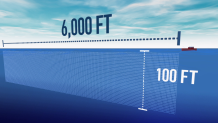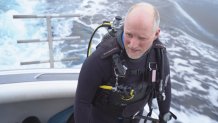Environmentalists scored a major victory in Sacramento Thursday after California lawmakers overwhelmingly voted to phase out the use of a controversial type of fishing gear known as drift gillnets: mile-long nets blamed for unintentionally killing thousands of sea creatures, including endangered animals.
Over the past 28 years, drift gillnets have entangled and killed an estimated 4,000 dolphins, 456 whales and 136 sea turtles, according to government data obtained from the National Oceanic and Atmospheric Organization. The federal agency, which regulates the fishing gear, randomly places observers on about 20 percent of all fishing trips that utilize the gear in an effort to document the environmental impact.
"We're being villainized, unjustly"

California fishermen view the ban as extreme and unnecessary, and believe their livelihood is being unfairly targeted. Without the fishing gear, they fear they won’t be able to continue making a living.
“I don’t know what I’d do,” said Mike Flynn, who has depended on drift gillnets to catch swordfish for the past 40 years. “There’s very few of us left, and we don’t seem to have a chance...we're being villainized, unjustly."
Only about 20 fisherman actively use the gear off the California coast; that's down from 141 active permits at the peak back in 1990, according to NOAA.
Local
Critics believe a phase out of the gear will ultimately cause even more damage to the environment by inviting more seafood imports from other countries.
"It’ll be supplied by foreign fleets that have little to no regulations," Flynn said. "If we ended up being put out of business, there will still be the demand, but the supply will be just coming from foreign countries that are not going to be abiding by the regulations that we abide by currently."

Environmentalists call them 'Death Nets'
The campaign to ban the nets gained momentum three years ago after four environmental groups joined together to lobby against the gear. Sea Legacy, Sharkwater, Mercy for Animals, and Turtle Island Restoration Network sent photographers underwater and undercover to capture images of the nets and the sea life they managed to entangle off the California coast.
“What do you mean in the waters of California," wondered marine biologist and National Geographic photographer Paul Nicklen. "I'm like, I'm going to go see this firsthand for myself."
Nicklen, well known for his shocking images of a starving polar bear in the Arctic, was taken aback when he heard about the drift gillnets and decided to travel to California to see the fishing firsthand.

"I've never seen anything like it"
Nicklen and his team spent months preparing for their expedition. They loaded $100,000 worth of cameras onto high speed scooters and, under the cover of darkness, raced out to sea to find the drift gillnets.
"The sun had not come up yet," said Nicklen. "You could just sort of barely see around as we're descending along this net, and by the time I got down to 120 feet deep, it was almost dark pitch black."
Nicklen said he was amazed by the size of the nets.
"I've never seen anything like it," he said. "The way the current was pushing it in these waves, it was like this undulating, moving death machine."
Nicklen wants the nets banned, even if that means putting fishermen out of business.
"For every fisherman out there, there's another 100 people out there that depend on a healthy ocean to make a living," he said. "Enough is enough. Let's let the world weigh in on it, and let's end this."
Famed Photographer, Biologist Paul Nicklen on Journey to Ban California's Controversial Fishing Nets
Marine Populations Growing
"We're not hurting the population," said David Haworth, a San Diego-based fisherman who has used drift gillnets off the California coast for roughly 40 years. "Since 1980, when the fishery started until now, the marine mammal population has exploded."
Since 2001, use of the nets has been prohibited along large portions of the California coast for six months of the year in order to avoid entangling migrating sea turtles, which haven't been snagged in six years. Since the late 1990s, fishermen have also been required to install high frequency noise making devices along their nets in hopes of scaring away dolphins and whales. Since then, far fewer marine animals have been caught, and their populations are growing.
Heidi Dewar is a Fisheries Research biologist from NOAA who studies the movement of fish and sharks. Based on her own research, and the work of other marine biologists, she’s convinced that improvements to the swordfish fishery are allowing the marine mammal populations to bounce back.
“It’s easy to get people emotionally charged when you’re talking about marine mammals,” she said. "For some people, one sea lion death is too much, but we’re looking at it from a practical, sustainable point of view. If you look at it that way, these populations are sustainable and will continue in perpetuity under the current rate of removal.”
Marine Mammal Populations Growing
Percentage increase in regions along West Coast (2008-2017)
Source: National Oceanic and Atmospheric Administration
if("undefined"==typeof window.datawrapper)window.datawrapper={};window.datawrapper["vN5Ad"]={},window.datawrapper["vN5Ad"].embedDeltas={"100":230,"200":230,"300":230,"400":230,"500":230,"700":230,"800":230,"900":230,"1000":230},window.datawrapper["vN5Ad"].iframe=document.getElementById("datawrapper-chart-vN5Ad"),window.datawrapper["vN5Ad"].iframe.style.height=window.datawrapper["vN5Ad"].embedDeltas[Math.min(1e3,Math.max(100*Math.floor(window.datawrapper["vN5Ad"].iframe.offsetWidth/100),100))]+"px",window.addEventListener("message",function(a){if("undefined"!=typeof a.data["datawrapper-height"])for(var b in a.data["datawrapper-height"])if("vN5Ad"==b)window.datawrapper["vN5Ad"].iframe.style.height=a.data["datawrapper-height"][b]+"px"});
Note: This chart represents the average growth of several species in a given region. Species were counted in different regions (ex: Northern California and Southern California) in 2008 and 2017. The growth of each region was combined into a single average.
Credit: Sean Myers/NBC Bay Area
Drift Gillnet Deaths
Sea Life Entangled, Killed, and Tossed Back to Sea
if("undefined"==typeof window.datawrapper)window.datawrapper={};window.datawrapper["DvtKs"]={},window.datawrapper["DvtKs"].embedDeltas={"100":226,"200":172,"300":172,"400":172,"500":172,"700":172,"800":172,"900":172,"1000":172},window.datawrapper["DvtKs"].iframe=document.getElementById("datawrapper-chart-DvtKs"),window.datawrapper["DvtKs"].iframe.style.height=window.datawrapper["DvtKs"].embedDeltas[Math.min(1e3,Math.max(100*Math.floor(window.datawrapper["DvtKs"].iframe.offsetWidth/100),100))]+"px",window.addEventListener("message",function(a){if("undefined"!=typeof a.data["datawrapper-height"])for(var b in a.data["datawrapper-height"])if("DvtKs"==b)window.datawrapper["DvtKs"].iframe.style.height=a.data["datawrapper-height"][b]+"px"});
Source: National Oceanic and Atmospheric Administration
Credit: Sean Myers/NBC Bay Area
California Lawmakers Overwhelmingly Vote to Ban Fishing Gear
On Thursday, California lawmakers passed Senate Bill 1017, which requires drift gillnets be phased out by January 2023.
Governor Jerry Brown has until Sept. 30 to decide whether to approve the ban. While Brown wouldn't comment on his upcoming decision, it appears the legislature has enough votes to override him if he does opt to veto the bill. The Senate passed the measure 36 to 1, while the Assembly voted 78 to 0 to support the measure.
The new law, pending Brown's approval, will also pay fishermen up to $110,000 if they enter into an agreement by January 2020 to retire their nets.

Fishermen argue the buyout option isn't nearly enough to purchase the kind of equipment and permits needed to transition to a different type of fishing.
“They're just telling us, ‘Hey, here's one hundred thousand dollars, good luck for the rest of your life,” said Mike Flynn.
WATCH: Part 1 of this investigative series
WATCH: Part 2 of this investigative series
.large div.leadMediaRegion {border:none} .large .leadMediaRegion.city_module iframe {height:615px;}
______________________________________
Need to contact our Investigative Unit?
• You can remain anonymous
• 1-888-996-TIPS
______________________________________
[[494566881, C]]



